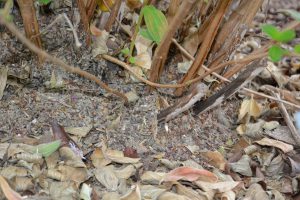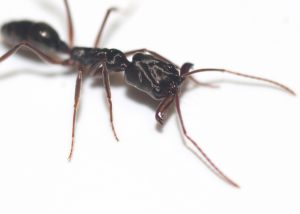One of the interesting ants that I am seeing more commonly in landscape settings is the Trap jaw ant (Odontomachus sp.). This ant is so named because of it’s large mandibles (mouthparts) that spring shut capturing prey. These mouthparts can also be used as a defensive mechanism allowing the ant to spring away from something it encounters.
A nesting area is very recognizable after you have seen one because it looks like a collection of soil and small wood debris piled at the base of plants or old stumps. I have encountered nesting areas around living shrubs in many mulched areas of the landscape and under pots sitting on old tree stumps.

Nesting debris from the Trapjaw ants at the base of a Princess flower. Photo by Beth Bolles, UF / IFAS Extension Escambia County.
My first experience with the trap jaw ant was not very pleasant. I was working in a mulched area pulling a few weeds without gloves. I unknowingly disturbed the nest and received a pain sting similar to a paper wasp sting. The discomfort was short-lived and I personally did not have inflammation or inching a few minutes later. Of course, I identified the ant and have since become very familiar with recognizing nesting spots.
Although trap jaw ants are not native to our area, they do not rank in the same category as fire ants which are both economically and medically problematic. Since trap jaw ants are currently found in more natural areas of the landscape, homeowners should just be aware of their presence. Consider a pair of gloves or garden tools when rooting around in mulch. When a nesting area is disturbed, the large ants (about .5 inches) will be easy to observe as one of the more interesting ants we may encounter.
- Garden Spider Egg Sacs - October 23, 2025
- Saving Malabar Spinach Seeds - October 17, 2025
- Improve Butterfly Habitat with Trees - September 18, 2025

